window Lancia Delta 2015 Owner handbook (in English)
[x] Cancel search | Manufacturer: LANCIA, Model Year: 2015, Model line: Delta, Model: Lancia Delta 2015Pages: 291, PDF Size: 6.74 MB
Page 175 of 291
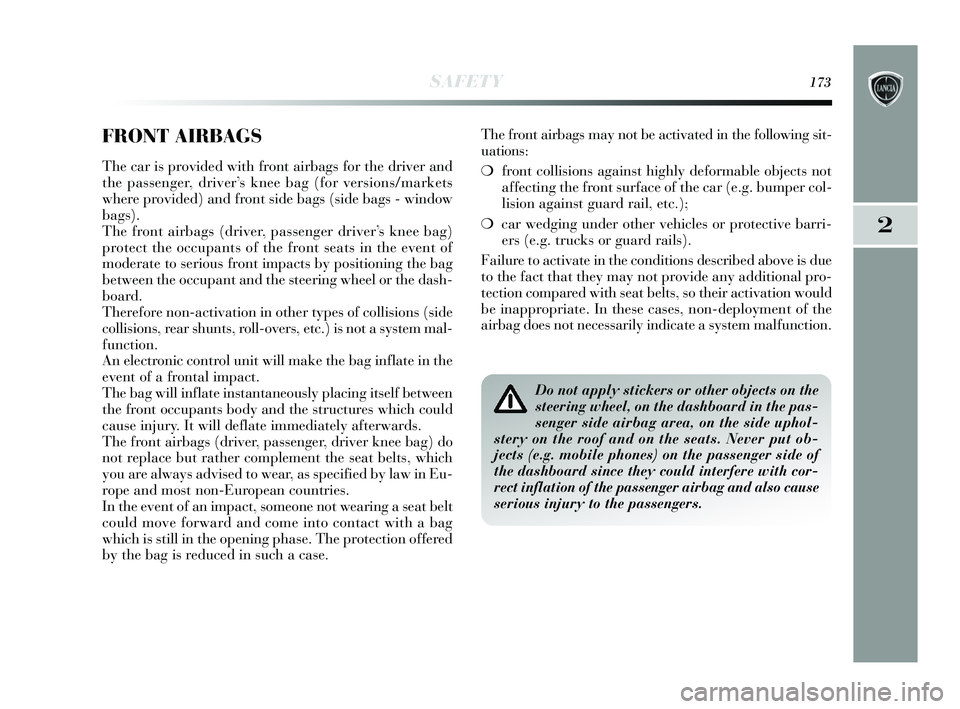
SAFETY173
2
FRONT AIRBAGS
The car is provided with front airbags for the driver and
the passenger, driver’s knee bag (for versions/markets
where provided) and front side bags (side bags - window
bags).
The front airbags (driver, passenger driver’s knee bag)
protect the occupants of the front seats in the event of
moderate to serious front impacts by positioning the bag
between the occupant and the steering wheel or the dash-
board.
Therefore non-activation in other types of collisions (side
collisions, rear shunts, roll-overs, etc.) is not a system mal-
function.
An electronic control unit will make the bag inflate in the
event of a frontal impact.
The bag will inflate instantaneously placing itself between
the front occupants body and the structures which could
cause injury. It will deflate immediately afterwards.
The front airbags (driver, passenger, driver knee bag) do
not replace but rather complement the seat belts, which
you are always advised to wear, as specified by law in Eu-
rope and most non-European countries.
In the event of an impact, someone not wearing a seat belt
could move forward and come into contact with a bag
which is still in the opening phase. The protection offered
by the bag is reduced in such a case.The front airbags may not be activated in the following sit-
uations:
❍
front collisions against highly deformable objects not
affecting the front surface of the car (e.g. bumper col-
lision against guard rail, etc.);
❍ car wedging under other vehicles or protective barri-
ers (e.g. trucks or guard rails).
Failure to activate in the conditions described above is due
to the fact that they may not provide any additional pro-
tection compared with seat belts, so their activation would
be inappropriate. In these cases, non-deployment of the
airbag does not necessarily indicate a system malfunction.
Do not apply stickers or other objects on the
steering wheel, on the dashboard in the pas-
senger side airbag area, on the side uphol-
stery on the roof and on the seats. Never put ob-
jects (e.g. mobile phones) on the passenger side of
the dashboard since they could interfere with cor-
rect inflation of the passenger airbag and also cause
serious injury to the passengers.
155-182 Delta GB 1ed 26/08/13 11.29 Pagina 173
Page 180 of 291

178SAFETY
SIDE BAGS (Side bag - Window bag)
SIDE BAG fig. 15
It consists of an instantly inflating bag housed in the front
seat backrest. It protects the chest and the pelvis of the
passengers in the event of side crashes of medium-high
severity.WINDOW BAGS fig. 16
This is formed by two “curtain” window bags located be-
hind the side roof cover and are covered by special trim.
They are designed to protect the head of front and rear
passengers in the event of side collisions, thanks to the
wide cushion inflation surface.
IMPORTANT In the event of a side impact, the system
provides best protection if the passenger sits on the seat in
a correct position, thus allowing correct window bag de-
ployment.
fig. 15L0E0070mfig. 16L0E0071m
155-182 Delta GB 1ed 26/08/13 11.29 Pagina 178
Page 181 of 291

SAFETY179
2
IMPORTANT The front airbags and/or side bags may ac-
tivate in the event of sharp knocks to the underbody of the
vehicle (e.g. impact with steps, pavements, potholes or
road bumps etc.).
IMPORTANT A small amount of dust will be released
when the airbags are deployed. The dust is harmless and
does not indicate the beginning of a fire. Furthermore, the
surface of the deployed bag and the interior of the car may
be covered with dusty residue. This dust can irritate skin
and eyes. Wash with mild soap and water in the event of
exposure.
IMPORTANT Pretensioners, front airbags and side bags
are deployed according to different logic on the basis of
the type of collision. Non-deployment of one or more of
the devices does not therefore indicate a system malfunc-
tion.Do not rest your head, arms or elbows on the
door, on the windows and on the window bag
area to avoid injuries during inflation. Nev-
er lean your head, arms or elbows out of the win-
dow.
IMPORTANT Should an accident occur activating any of
the safety devices, take the car to a Lancia Dealership to
have the activated devices replaced and the system
checked.
Airbag checking, repair and replacement must only be car-
ried out at a Lancia Dealership. If you are having the car
scrapped, have the airbag system deactivated at a Lan-
cia Dealership first. If the car changes ownership, the new
owner must be informed of the method of use of airbags
and the above warnings and also be given this “Owner
Handbook”.
155-182 Delta GB 1ed 26/08/13 11.29 Pagina 179
Page 191 of 291
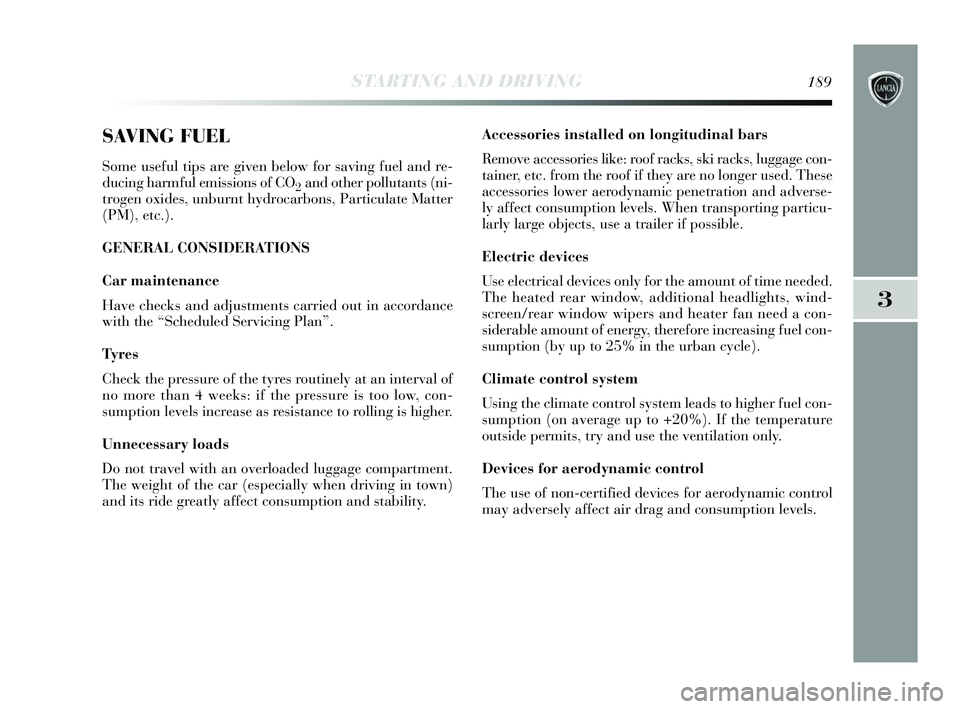
STARTING AND DRIVING189
3
SAVING FUEL
Some useful tips are given below for saving fuel and re-
ducing harmful emissions of CO
2and other pollutants (ni-
trogen oxides, unburnt hydrocarbons, Particulate Matter
(PM), etc.).
GENERAL CONSIDERATIONS
Car maintenance
Have checks and adjustments carried out in accordance
with the “Scheduled Servicing Plan”.
Ty r e s
Check the pressure of the tyres routinely at an interval of
no more than 4 weeks: if the pressure is too low, con-
sumption levels increase as resistance to rolling is higher.
Unnecessary loads
Do not travel with an overloaded luggage compartment.
The weight of the car (especially when driving in town)
and its ride greatly affect consumption and stability. Accessories installed on longitudinal bars
Remove accessories like: roof racks, ski racks, luggage con-
tainer, etc. from the roof if they are no longer used. These
accessories lower aerodynamic penetration and adverse-
ly affect consumption levels. When transporting particu-
larly large objects, use a trailer if possible.
Electric devices
Use electrical devices only for the amount of time needed.
The heated rear window, additional headlights, wind-
screen/rear window wipers and heater fan need a con-
siderable amount of energy, therefore increasing fuel con-
sumption (by up to 25% in the urban cycle).
Climate control system
Using the climate control system leads to higher fuel con-
sumption (on average up to +20%). If the temperature
outside permits, try and use the ventilation only.
Devices for aerodynamic control
The use of non-certified devices for aerodynamic control
may adversely affect air drag and consumption levels.
183-194 Delta GB 1ed 26/08/13 12.15 Pagina 189
Page 195 of 291

STARTING AND DRIVING193
3
Keep your speed down when snow chains are
fitted. Do not exceed 50 km/h. Avoid potholes,
steps and pavements and also avoid driving
long distances on roads not covered with snow in
order to prevent damaging the car and the roadbed.
SNOW CHAINS
The use of snow chains should be in compliance with lo-
cal regulations.
The snow chains may be applied only onto the front wheel
(drive wheels).
Check the tension of the snow chains after the first few
metres have been driven.
IMPORTANT Snow chains cannot be fitted to the space-
saver wheel. So, if a front (drive) wheel is punctured and
chains are needed, a rear wheel should be fitted to the front
of the car and the space-saver wheel should be fitted to
the rear. In this way, with two normal drive wheels at the
front, snow chains can be fitted.
CAR INACTIVITY
If the car is to be left inactive for longer than a month, the
following precautions should be followed:
❍ park the car in a covered, dry and, if possible, well-
ventilated place;
❍ engage a gear;
❍ check that the handbrake is not engaged;
❍ disconnect the negative battery terminal;
❍ clean and protect the painted parts of the vehicle with
protective wax;
❍ clean and protect the shiny metal parts using special
compounds commercially available;
❍ sprinkle talcum powder on the rubber windscreen and
rear window wiper blades and lift them off the glass;
❍ open the windows slightly;
❍ cover the car with a fabric or perforated plastic sheet.
Do not use sheets of non-perforated plastic as they do
not allow moisture on the car body to evaporate;
❍ inflate tyres to a pressure of +0.5 bar above the nor-
mal specified pressure and check regularly;
❍ do not drain the engine cooling system.
183-194 Delta GB 1ed 26/08/13 12.15 Pagina 193
Page 229 of 291
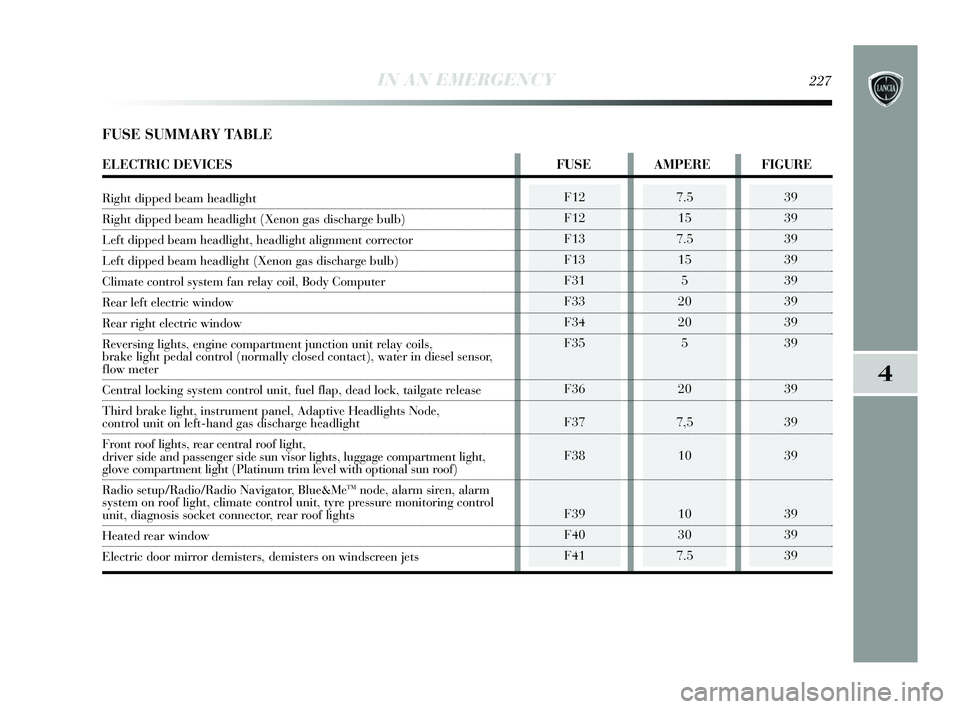
IN AN EMERGENCY227
4
F12
F12
F13
F13
F31
F33
F34
F35
F36
F37
F38
F39
F40
F417.515
7.5 15 5
20
20 5
20
7,5 10
10
30
7.539
39
39
39
39
39
39
39
39
39
39
39
39
39
FUSE SUMMARY TABLE
ELECTRIC DEVICES FUSE AMPERE FIGURE
Right dipped beam headlight
Right dipped beam headlight (Xenon gas discharge bulb)
Left dipped beam headlight, headlight alignment corrector
Left dipped beam headlight (Xenon gas discharge bulb)
Climate control system fan relay coil, Body Computer
Rear left electric window
Rear right electric window
Reversing lights, engine compartment junction unit relay coils,
brake light pedal control (normally closed contact), water in diesel sensor,
flow meter
Central locking system control unit, fuel flap, dead lock, tailgate release
Third brake light, instrument panel, Adaptive Headlights Node,
control unit on left-hand gas discharge headlight
Front roof lights, rear central roof light,
driver side and passenger side sun visor lights, luggage compartment lig\
ht,
glove compartment light (Platinum trim level with optional sun roof)
Radio setup/Radio/Radio Navigator, Blue&Me
TMnode, alarm siren, alarm
system on roof light, climate control unit, tyre pressure monitoring control
unit, diagnosis socket connector, rear roof lights
Heated rear window
Electric door mirror demisters, demisters on windscreen jets
195-232 Delta GB 1ed 03/03/14 09.15 Pagina 227
Page 230 of 291

39
39
39
39
39
39
39
39
39
228IN AN EMERGENCY
F43
F44
F46
F47
F48
F49
F51
F52
F5330
15
20
20
205
5/7.5 (*)
15
7.5
ELECTRIC DEVICES FUSE AMPERE FIGURE
Windscreen wiper system on steering column stalk, bi-directional windscreen/rear window washer electrical pump system on steering column stalk
Cigar lighter/power socket on tunnel,
luggage compartment power socket
Sun roof motor
Driver’s front electric window
Passenger side front electric window
Hazard, right, left and central control panels (lighting),
steering wheel controls (lighting), controls on front roof light
(lighting), volumetric alarm system control unit,
electric sun roof system (control unit, control lighting),
rain/dusk sensor, electro-chromic mirror,
front seat heating controls, AUX socket (lighting)
Cigar lighter (lighting), radio setup,
Cruise Control system control, Blue&Me
TMnode, parking sensor node,
AQS sensor, climate control system, electric door mirror
adjustment, tyre pressure monitoring control unit, Lane assistance
node, Controlled damping suspension node, Eco button
(versions with automatic transmission), automatic transmission control
light guide, control unit on right-hand gas discharge headlight
Rear window wiper system on steering column stalk
Instrument panel, rear direction indicators
195-232 Delta GB 1ed 03/03/14 09.15 Pagina 228
Page 235 of 291
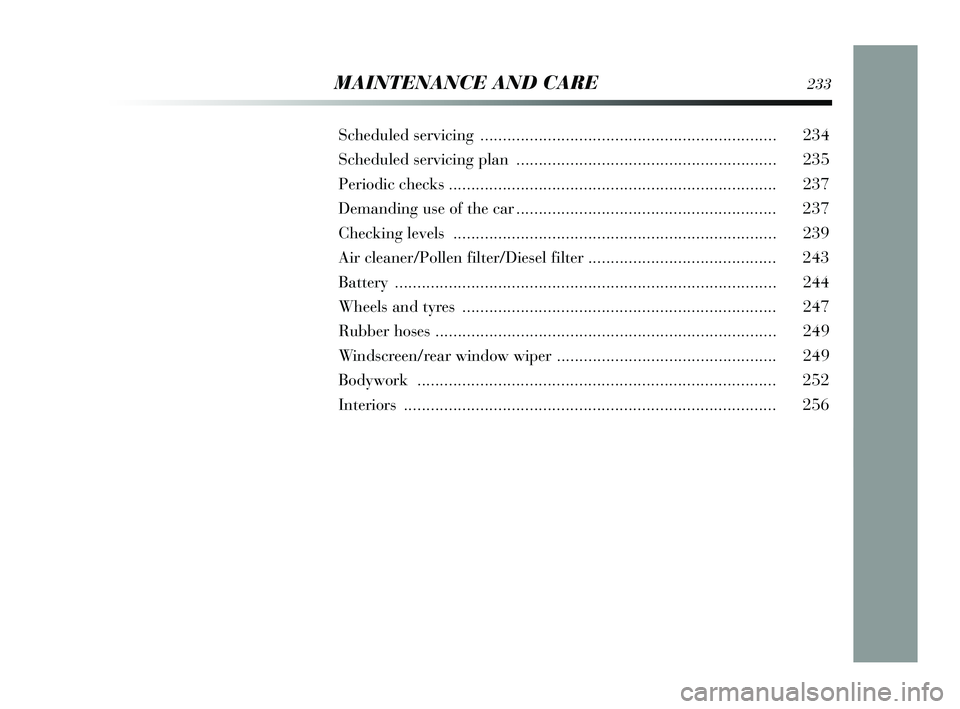
MAINTENANCE AND CARE233
Scheduled servicing .................................................................. 234
Scheduled servicing plan .......................................................... 235
Periodic checks ........................................................................\
. 237
Demanding use of the car .......................................................... 237
Checking levels ........................................................................\
239
Air cleaner/Pollen filt er/Diesel filter.......................................... 243
Battery .......................................................................\
.............. 244
Wheels and ty res ...................................................................... 247
Rubber hoses ......................................................................\
...... 249
Windscreen/rear window wiper ................................................. 249
Bodywork ........................................................................\
........ 252
Interiors ........................................................................\
........... 256
233-256 Delta GB 1ed 03/04/14 13:27 Pagina 233
Page 237 of 291
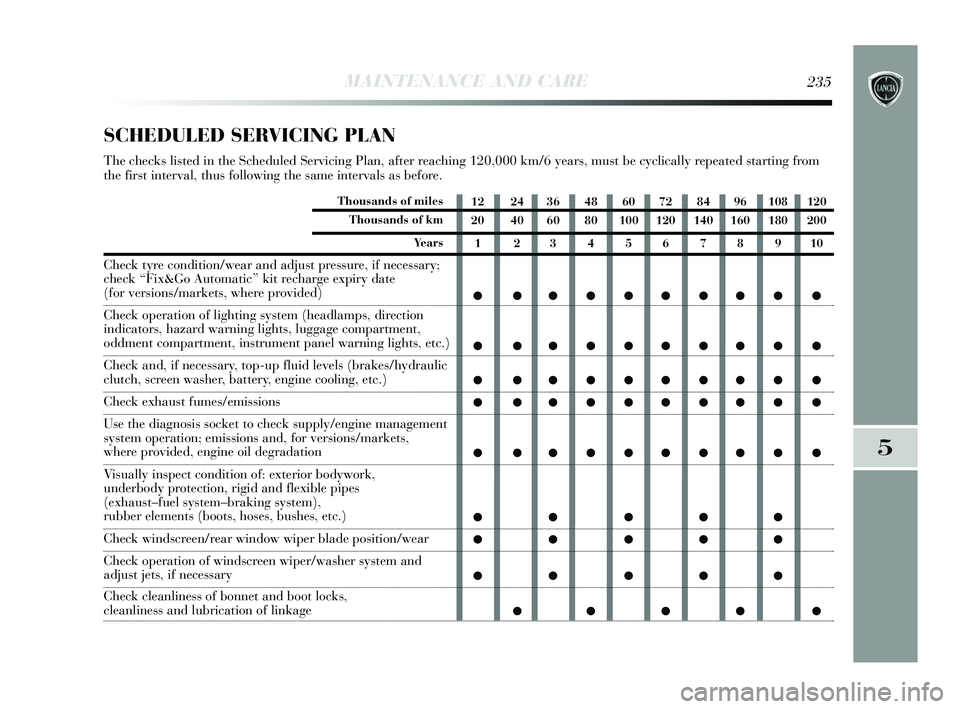
MAINTENANCE AND CARE235
5
12 24 36 48 60 72 84 96 108 120
20 40 60 80 100 120 140 160 180 2001 2345678910
● ●●●●●●●● ●
● ●●●●●●●● ●
● ●●●●●●●● ●
● ●●●●●●●● ●
● ●●●●●●●● ●
● ● ●●●
● ● ●●●
● ● ●●● ●●●● ●
SCHEDULED SERVICING PLAN
The checks listed in the Scheduled Servicing Plan, after reaching 120,000 km/6 years, must be cyclically repeated starting from
the first interval, thus following the same intervals as before.
Thousands of miles
Thousands of km
Years
Check tyre condition/wear and adjust pressure, if necessary;
check “Fix&Go Automatic” kit recharge expiry date
(for versions/markets, where provided)
Check operation of lighting system (headlamps, direction
indicators, hazard warning lights, luggage compartment,
oddment compartment, instrument panel warning lights, etc.)
Check and, if necessary, top-up fluid levels (brakes/hydraulic
clutch, screen washer, battery, engine cooling, etc.)
Check exhaust fumes/emissions
Use the diagnosis socket to check supply/engine management
system operation; emissions and, for versions/markets,
where provided, engine oil degradation
Visually inspect condition of: exterior bodywork,
underbody protection, rigid and flexible pipes
(exhaust–fuel system–braking system),
rubber elements (boots, hoses, bushes, etc.)
Check windscreen/rear window wiper blade position/wear
Check operation of windscreen wiper/washer system and
adjust jets, if necessary
Check cleanliness of bonnet and boot locks,
cleanliness and lubrication of linkage
233-256 Delta GB 1ed 03/04/14 13:27 Pagina 235
Page 239 of 291
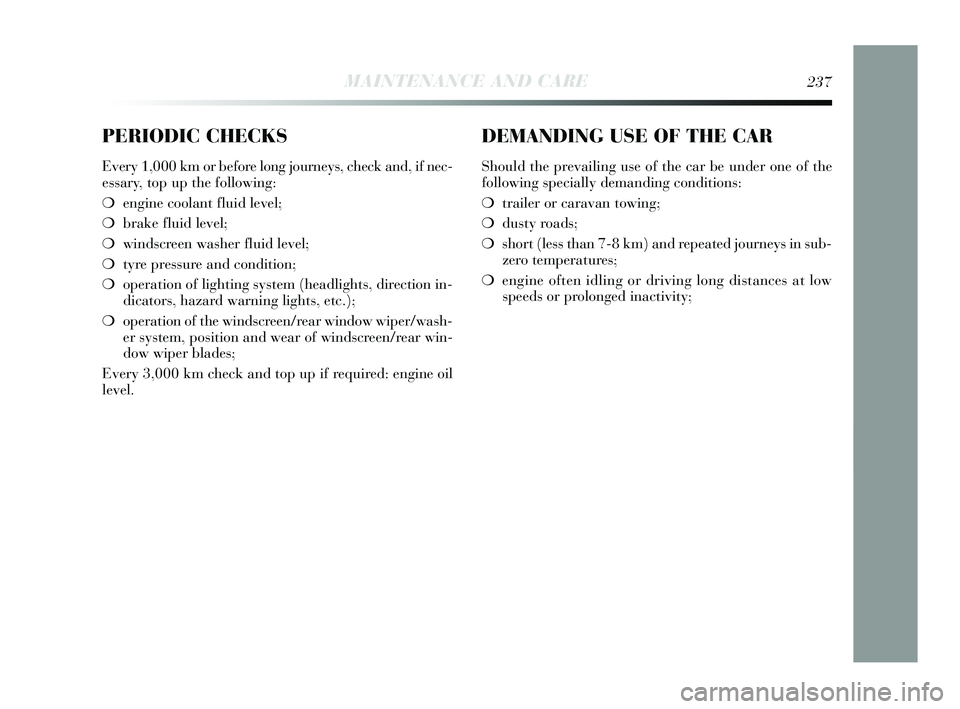
PERIODIC CHECKS
Every 1,000 km or before long journeys, check and, if nec-
essary, top up the following:
❍engine coolant fluid level;
❍ brake fluid level;
❍ windscreen washer fluid level;
❍ tyre pressure and condition;
❍ operation of lighting system (headlights, direction in-
dicators, hazard warning lights, etc.);
❍ operation of the windscreen/rear window wiper/wash-
er system, position and wear of windscreen/rear win-
dow wiper blades;
Every 3,000 km check and top up if required: engine oil
level.
DEMANDING USE OF THE CAR
Should the prevailing use of the car be under one of the
following specially demanding conditions:
❍ trailer or caravan towing;
❍ dusty roads;
❍ short (less than 7-8 km) and repeated journeys in sub-
zero temperatures;
❍ engine often idling or driving long distances at low
speeds or prolonged inactivity;
MAINTENANCE AND CARE237
233-256 Delta GB 1ed 03/04/14 13:27 Pagina 237